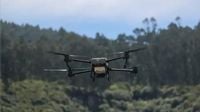In a troubling development for European security, authorities in Italy have launched an investigation into suspected drone activity linked to Russia. The anti-terrorism unit of the Milan prosecutor's office is set to officially open the probe on March 31, 2025, following reports of multiple unauthorized drone flights over the EU Joint Research Centre (JRC) in Ispra, located on the picturesque shores of Lake Maggiore.
According to the Corriere della Sera, at least five flights of a drone, or possibly more, of suspected Russian origin were detected over the JRC during March. The flights raised alarms among researchers and security officials, especially since the area is classified as a "no fly zone." The JRC itself is currently engaged in a project focusing on the safety aspects of drones, making the situation even more concerning.
The drone flights reportedly occurred repeatedly over a week's span, with the JRC raising the alarm after intercepting signals from the aircraft. Experts assert that the drone in question is of Russian manufacture, capable of detailed surveillance, including night-time filming and three-dimensional mapping of sensitive areas. This capability only heightens the urgency of the investigation.
Security sources have indicated that there is "maximum caution" regarding the dynamics of the drone activity and its potential implications. While it seems unlikely that a drone could have traveled directly from Russia to Italy, the proximity of the JRC to critical national infrastructure complicates the matter. Just a short distance away are the factories of Leonardo, a major player in the defense and aerospace sector, and the operational headquarters of a NATO command in Solbiate Olona.
The JRC itself is noteworthy; established in 1960 as a nuclear research facility, it has grown into one of the leading research campuses in Europe. It is the third largest research center of the European Commission, following those in Brussels and Luxembourg. The JRC employs a staff of experts who work in diverse fields such as nuclear safety, energy efficiency, climate change, and space.
One of the JRC's key laboratories, known as WaterLab, focuses on analyzing water quality to detect harmful chemicals. Another significant facility is the European solar test installation (Esti), which has been instrumental since the 1970s in setting European and global standards for photovoltaics. In addition, the JRC operates a crisis management room (ECML) where scientists monitor natural disasters and assist states in emergency management, employing data from the Copernicus satellite program.
This recent incident echoes a tragic event from 2023 in the same region, where the Love Lake vessel sank during bad weather, resulting in the deaths of secret agents from the Italian Aise and the Israeli Mossad. That tragedy has left lingering questions about security in the area, making the current drone sightings even more alarming.
As investigations proceed, there is speculation that the Interministerial Committee for the Security of the Republic may have already discussed this matter in a recent meeting held on March 28, 2025. The presence of high-stakes facilities in close proximity to the JRC raises concerns about potential espionage or surveillance attempts on sensitive national and European security targets.
While the precise origin of the drone remains unclear, the capabilities of such devices are well-documented. Drones can be equipped with advanced cameras and digital instruments that allow for detailed surveillance, which could pose significant risks if used maliciously. The ability to conduct aerial surveillance in a sensitive area like the JRC underscores the potential threat posed by unauthorized drone activity.
In response to these events, the Italian authorities are taking a cautious approach, emphasizing the importance of thorough investigations to ensure national security. The ongoing probe by the Milan prosecutor's office will focus on uncovering the details surrounding these drone flights and determining whether they were part of a larger pattern of espionage or other malicious intent.
As the situation develops, it is clear that the intersection of drone technology and national security will continue to be a focal point for both researchers and policymakers in Europe. The implications of such incidents extend beyond immediate security concerns, raising questions about the adequacy of existing regulations and the need for enhanced protective measures around critical infrastructures.
In conclusion, the investigation into the suspected Russian drones over the EU Joint Research Centre serves as a stark reminder of the evolving challenges in maintaining security in an increasingly complex technological landscape. With the potential for drones to be used for espionage or surveillance, the need for vigilance and proactive measures has never been more pressing.





